 .
.
Don’t Dangle Your Participle
by Vanita Oelschlager & Mike DeSantis, illustrator
Vanita Books 5/01/2014
978-1-938164-02-6
Age 4 to 8 24 pages
.
“Words and pictures show children what a dangling participle is all about. Young readers are shown an incorrect sentence that has in it a dangling participle. They are then taught how to make the sentence read correctly. It is done in a cute and humorous way. The dangling participle loses its way and the children learn how to help it find its way back to the correct spot in the sentence. This is followed by some comical examples of sentences with dangling participles and their funny illustrations, followed by an illustration of the corrected sentence. Young readers will have fun recognizing this problem in sentence construction and learning how to fix it.”
Opening
“What on earth is a participle and how does it dangle? Okay. Okay. Let’s start from the beginning.”
Review
In Don’t Dangle Your Participle Vanita explains what a dangling participle is and explains how to fix the sentence so that the participle no longer dangles and mangles the sentence’s meaning. The participle comes before the noun to clarify it, but Vanita shows how easy it is for the modifier to get lost, ending up in the wrong place in the sentence. If you still don’t get it from that explanation, well, this is because explanations are easier to understand when Vanita adds in pictures to make her point.
And it works!
I know this because dangling participles (and dangling modifiers, but that is another story) have always confused me, BUT honest, after reading Don’t Dangle Your Participle, I understand what a dangling participle is and how to correct the sentence and send the raskly participle on its way to bother someone else’s sentence. Don’t Dangle Your Participle belongs in every school library and language arts classrooms. Using humorous illustrations, Vanita shows how the participle, when left to dangle, changes the meaning of the sentences often with disastrous consequences. Try this one.
- While riding his skateboard in the park, a deer almost ran into Lester.
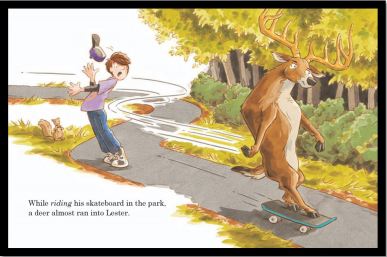
What this sentence is saying is this: When the deer rode his skateboard in the park, it almost ran into Lester. This is not what the sentence was supposed to mean. The dangling Participle—riding—changed the meaning of the sentence to something unintended and, as shown by the illustration, often something unintentionally funny. Vanita clearly shows kids how to fix these sentences.
Did you get the correct sentence? Maybe another illustration will help.
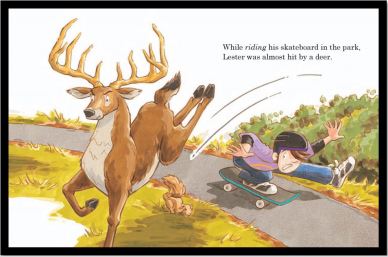
Correct: While riding his skateboard in the park, Lester was almost hit by a deer.
Vanita has a canny way of helping kids understand English and its many rules. She effectively uses humor, which can help a child remember a concept. The more senses involved in learning, the better the material will be remembered. Vanita easily explains a subject, breaking it down so that kids can get the concept quickly. Don’t Dangle Your Participle may be her best language arts book yet.
Don’t Dangle Your Participle can help teachers explain sentence structure in general and the dangling participle. Many of Vanita’s books make great adjunct texts, especially in a homeschooling situation. For those kids that like to learn, Vanita Books make learning loads of fun. Don’t Dangle Your Participle helps the teacher and student, and charitable organizations—all net profits go to select charities. Try one more. Are you ready?
- Melting in the hot sun, Ida rushed to finish her ice cream.

This sentence says, As Ida was melting, she rushed to finish her ice cream. The dangling participle—melting—changed the meaning of this sentence. The writer is trying to say, the ice cream was melting, but darn it, he dangled the participle!
I bet you figured out the correct sentence. Just in case, here it is with a visual aide.

Correct: Melting in the hot sun, the ice cream had to be finished quickly
English is a difficult language. The rules are numerous and onerous. Kids need all the help they can get in understanding how to write English. Don’t Dangle Your Participle can be that help and should be available to every school child by way of the classroom and the library. Vanita explains the participle—a verb that acts like an adjective—and what happens when the participle no longer comes before the proper noun—it dangles. Her use of fun and funny illustrations help drive home her explanations. If I can finally understand these dangerous dangling participles, kids will be able to and probably faster. Use Don’t Dangle Your Participle can be used at home and at school to increase your child’s ability to write English properly. A skill that will help children their entire life.
.
Learn more about Don’t Dangle Your Participle HERE.
Buy Don’t Dangle Your Participle at Amazon—B&N—Vanita Books—your local bookstore.
.
Meet the author, Vanita Oelschlager at her website: http://vanitabooks.com/MeetVanita.html
Meet the illustrator, Mike DeSantis at his website: http://www.mikedesantis.com/picblog/
Find more wonderful Vanita Books at the publisher’s website: http://vanitabooks.com/index.html
.
DON’T DANGLE YOUR PARTICIPLE. Text copyright © 2014 by Vanita Oelschlager. Illustrations copyright © 014 by Mike DeSantis. Reproduced by permission of the publisher, Vanita Books, Akron, OH.
. ALSO BY VANITA BOOKS
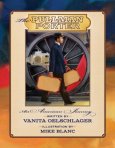
The Pullman Porter

Knees

Farfalla
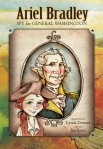
Ariel Bradley
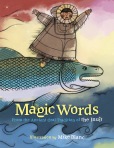
Magic Words
.
.
Reviews: The Pullmn Porter–Knees–Farfalla–Ariel Bradley–Magic Words

Filed under:
6 Stars TOP BOOK,
Children's Books,
Favorites,
Library Donated Books,
NonFiction,
Picture Book,
Top 10 of 2014 Tagged:
children's book reviews,
dangling participles,
English language,
language arts for kids,
Mike DeSantis,
sentence structure,
vanita books,
Vanita Oelschlager 







 .
.
The Pullman Porter: An American Journey
by Vanita Oelschlager & Mike Blanc
Vanita Books, Inc.** 2/01/2014
978-1-938164-00-2
Age 7 to 12 42 pages
.
Back Cover
“Children and adults under the age of 40 are forgetting about the Pullma Porter. They were very important figures in the history of America. This book will teach children and adults who the porters were and why they were so important in our history. Porters worked in early train cars, they would look, listen and learn from their predominantly white passengers. They would read the newspapers passengers left behind, listen to conversations and begin to talk to one another. The Porter learned how important education was for children and how important it was to take this message home to his children. He eventually landed at the forefront of the civil rights movement”
Opening
“Who was the most important African-American in the 100 years following the end of the Civil War in 1865?”
About
Railroads came to be important ways to travel in early America, starting with its inception in 1830. The ride was not accommodating. Travelers were uncomfortable and dirty, and ate only if they brought their own food. George Pullman changed all that. He built The Pullman Sleeping Car. It had fancy sleeping and dining cars. Those who could afford it ate fine meals and slept on mattresses dressed in fine linens. Pullman heated the trains and put in lights (candlelight).
The Civil War freed slaves and Pullman hired the best and smartest to work as train porters. Porters had numerous jobs; from maid to shoeshine boy, and both nurse and nursemaid. Porters carried rulebooks that spelled out how to handle every possible situation they could encounter, but their main role was making beds at night and turning them back into seats the next day. A passenger could fall out of bed, tossed by the train, if the porter made the bed incorrectly.
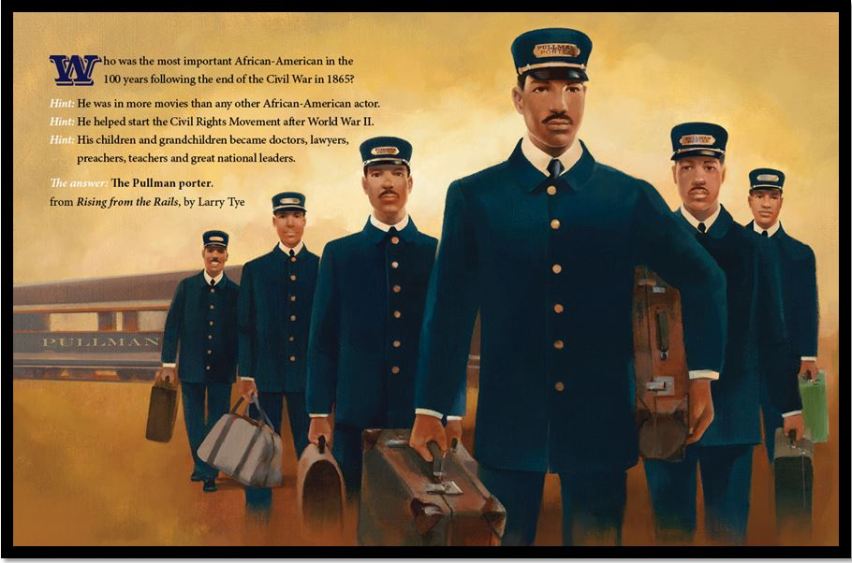
A porter’s appearance had to be “porter-perfect,” including the uniforms, which they had to buy. Porters earned little, depending more on tips earned by giving extra attention to, and doing extra things for, the customer. Most riders simply called the porters “George” after Mr. Pullman. Rarely did they bother to learn a porter’s real name. Pullman Porters worked 240 hours a month for as little as $10.
By 1925, the porters began unionizing, thanks to A. Philip Randolph, another porter. Twelve years later, in 1937 the union, The Brotherhood of Sleeping Car Porters, became reality. Better wages and working conditions were the result. In 1956, Pullman Porters held the Montgomery Bus Boycott, starting the civil rights movement. A. Philip Randolph introduced Martin Luther King at the Washington rally on August 28, 1963 and gave Mr. King the reigns to the civil rights movement. It was a porter, E. D. Nixon, who asked Rosa Parks to refuse a seat in the back of the bus.
By late 1960, Americans preferred to travel by airplane and the Pullman Porters began fading out. Pullman porters are important to America’s history. They struggled for equal rights, civil rights, and helped the exploration and settlement of the United States.
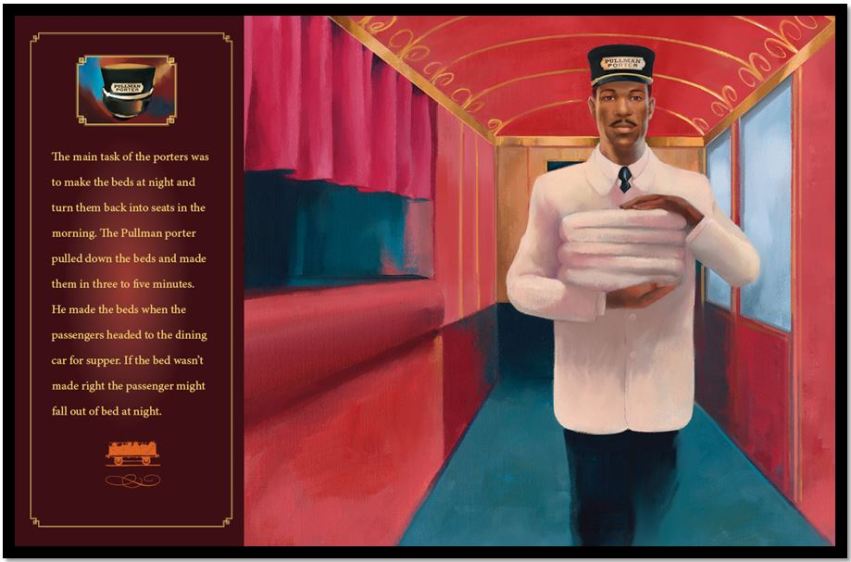
Review
The Pullman Porter: An American Journey tells the story of the Pullman Porters who worked hard making train travel comfortable for Americans exploring the United States. The book is a comfortable weight, with thick cream pages border in brown. The digitally finished paintings together became a book of realistic illustrations. Every page is a brown tone. The porters are meticulous in appearance.
The text is long for a picture book. Most young children will not sit through the story, but many would love the illustrations. The Pullman Porter makes a great elementary adjunct textbook. It seems Ms. Oelschlager did not leave any details out of her book. Elementary kids will learn this history thanks to the straightforward text and the realistic and engaging illustrations. Teachers can utilize The Pullman Porter in classroom discussions of the American West, early train transportation, the civil rights movement, and the early freedom of the African-American. The Pullman Porter, not being a dry textbook, will hold children’s attention and help them remember the lesson.
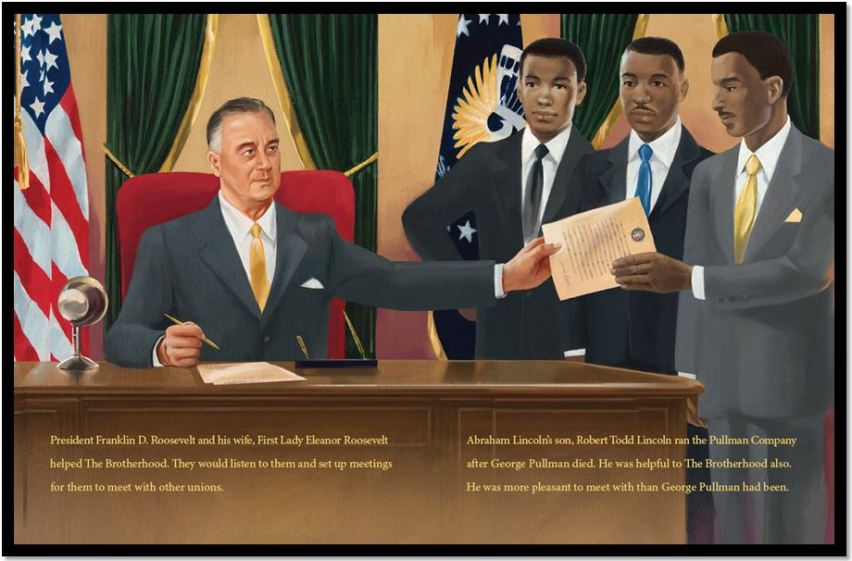
I like The Pullman Porter and was instantly attracted to the cover. Inside are many little bits of information a normal textbook will not tell you. Things like Whoopi Goldberg and Thurgood Marshall being descendants of Pullman porters. The porters being the catalyst for the civil rights movement is a fact I did not learn in any American History class. The Pullman Porter will entertain adults interested in American history or trains in general. I think kids from fourth grade up through middle grade will enjoy The Pullman Porter. Schools should make this book available on the shelves of their libraries. History comes alive between the pages of The Pullman Porter: An American Journey.
**Vanita Books is a for-profit business and donates all of their net profits to: Holt International, National Multiple Sclerosis Society, and The Oak Clinic for Multiple Sclerosis
Here is a Teacher’s Guide for The Pullman Porters.
.
Learn more about The Pullman Porters HERE.
Get a copy of The Pullman Porter: An American Journey at Amazon —B&N—Vanita Books—your local bookstore.
—B&N—Vanita Books—your local bookstore.
.
Meet Vanita Oelschlager HERE
Meet Mike Blanc HERE.
.
THE PORTER PULLMAN” AN AMERICAN JOURNEY. Text copyright © 2014 by Vanita Oelschlager. Illustrations © 2014 by Mike Blanc. Reproduced by permission of the publisher, Vanita Books, Inc., Akron, OH.
.
NEW FOR SPRING, 2014 AT VANITA BOOKS
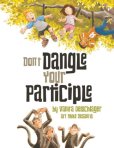 .
.
.
Don’t Dangle Your Participle
.
.

Filed under:
6 Stars TOP BOOK,
Children's Books,
Library Donated Books,
Middle Grade,
NonFiction,
Picture Book,
Top 10 of 2014 Tagged:
children's book reviews,
Civil rights movement,
Civil War,
George Pullman,
Mike Blanc,
Pullman Porters,
vanita books,
Vanita Oelschlager 







. Ariel Bradley, Spy for General Washington By Lynda Durrant Joe Rossi, illustrator Vanita Books 5 Stars . Press Release: Based on a true event. The real life adventures of nine-year-old Ariel Bradley, reveals the anxieties of the Americans who needed desperately to win the battle in the first months of the Revolutionary War. It …
I Came From the Water Vanita Oelschlager, author Mike Blanc, illustrator 4 Stars ………………………………….. I Came from Water (subtitled), One Haitian Boy’s Incredible Tale of Survival, is a story based on true events, told from the viewpoint of a surviving child. Moses was an infant when floods destroyed his hometown killing many people, including his [...]
5 Stars Sometimes I feel bad when I am in school. ………………..–Knees Louis the Third is in the fourth grade. He is a typical boy with bright, alert eyes and a kid-style smirk for a smile. Louis likes school—sometimes. School is not easy for Louis. He has a “mixed-up brain” that often sees things differently [...]
 .
.












 .
.


 .
.